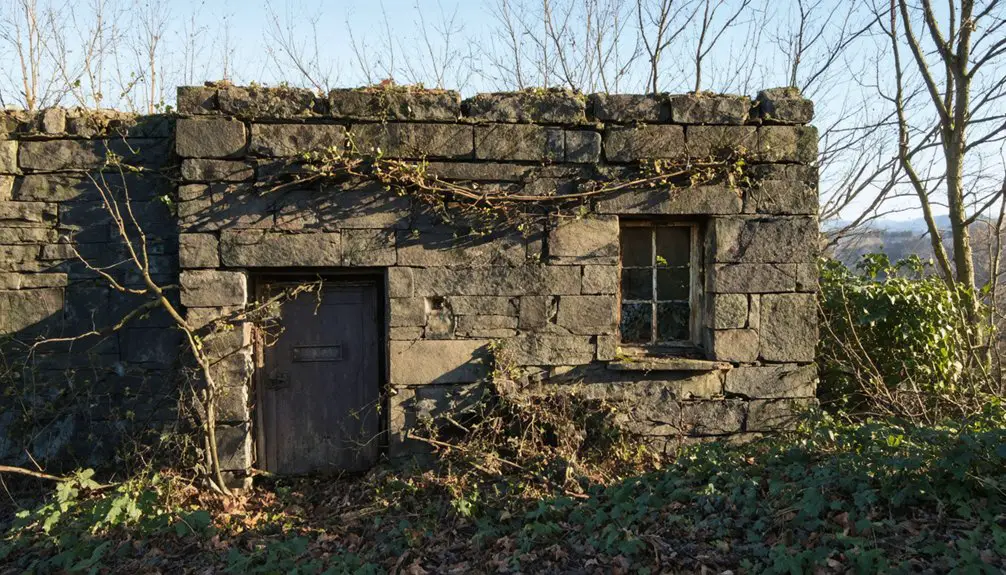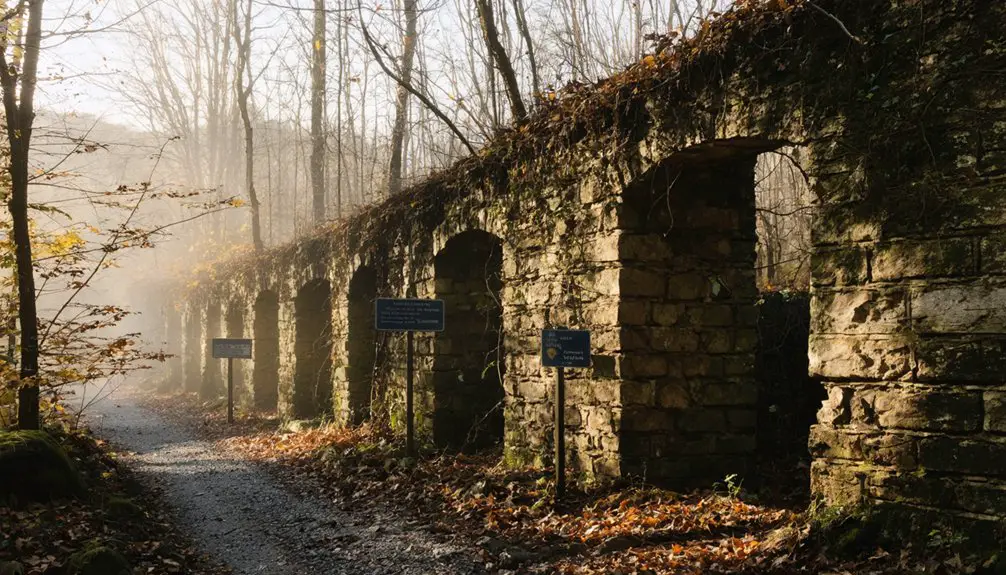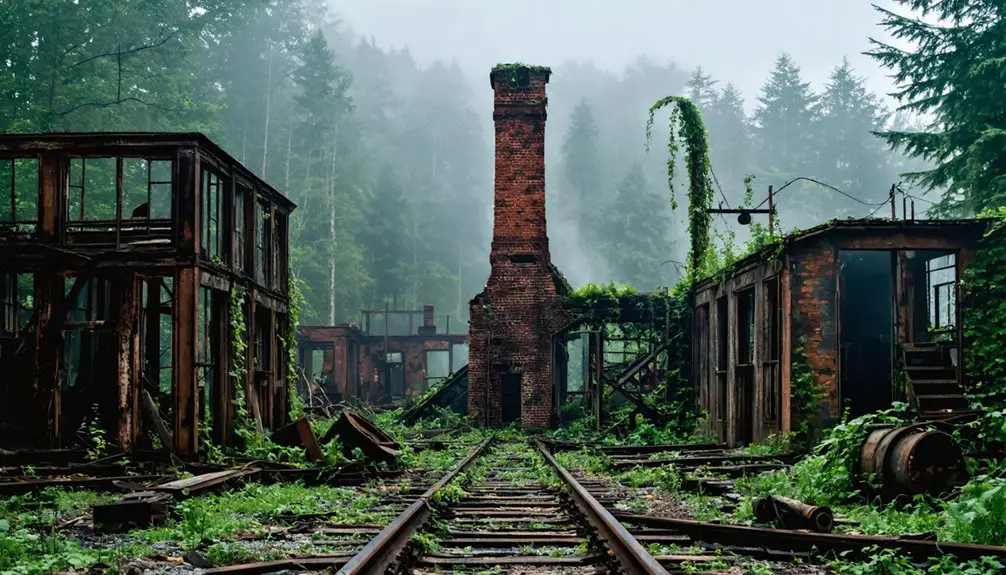You’ll find Buena Vista, Pennsylvania nestled along the Youghiogheny River, where a thriving 1,000-person mining community once stood. Named after an 1847 Mexican-American War victory, the town boomed in the early 1900s with the Vinton Colliery Company’s 84 company houses and a massive blast furnace producing 600 tons of pig iron annually. The Great Depression transformed it into a ghost town, but its crumbling foundations and abandoned mines tell an intriguing tale of America’s industrial past.
Key Takeaways
- Buena Vista transformed from a thriving coal mining town of 1,000 residents into a ghost town during the Great Depression.
- The Vinton Colliery Company built 84 company houses and established coal mines that defined the town’s industrial peak.
- Empty company stores, abandoned mine openings, and crumbling house foundations remain as evidence of the town’s decline.
- The Ghost Town Trail now runs through Buena Vista, offering 49 miles of paths showcasing the area’s industrial heritage.
- The town’s iconic 30-foot blast furnace, which produced 600 tons of pig iron annually, ceased operations in 1856.
The Battle of Buena Vista and Town Naming
While the Battle of Buena Vista in 1847 might seem distant from a Pennsylvania ghost town, this crucial Mexican-American War engagement directly influenced the town’s naming.
The battle’s significance emerged when U.S. forces under General Zachary Taylor, though outnumbered nearly four-to-one, secured a decisive victory against Mexican troops led by Santa Anna. Taylor’s strategic use of artillery and defensive positioning proved masterful in the mountain pass near the Buena Vista hacienda. Initial news of the battle reached American shores with rumors of Mexican victory. Mexican forces sustained approximately 1,500 casualties during the intense two-day battle.
You’ll find the naming legacy reflected in how 19th-century Americans commonly commemorated military victories through place names. The battle’s fame, combined with Taylor’s subsequent rise to the presidency, inspired multiple American towns to adopt the name “Buena Vista” – including this Pennsylvania settlement – as a symbol of American military pride.
Early Settlement and Mining Roots
When Lewis Wambaugh, a traveling shoemaker, first settled in Buena Vista in 1847, he couldn’t have predicted the bustling mining town it would become.
You’ll find that the settlement quickly grew on Jacob Adams’ land, attracting a rich tapestry of cultural diversity including Dutch, Swedish, English, and Scottish settlers.
The town’s early development centered around its prime location on the Youghiogheny River, with two dams supporting steamboat operations. The area’s elevation was notably higher than other nearby regions, similar to Buena Vista Township’s topography. Community organizations flourished, especially religious institutions like St. Paul’s Reformed Church.
Situated along the Youghiogheny River, Buena Vista grew from its waterfront roots into a thriving community of faith and commerce.
By the 1870s, Buena Vista had transformed into a crucial hub of the region’s coal and oil industry, boasting hardware stores, machine shops, and various merchant establishments.
The population swelled to nearly 1,000 residents during the peak of the oil boom. The success of the Argyle Savings Bank in 1872 reflected the town’s growing economic prosperity.
Peak Industrial Years and Population Growth
During the early 1900s, Buena Vista reached its industrial zenith as the Vinton Colliery Company established six major coal mines around 1916.
The town’s industrial growth transformed the landscape with the construction of 84 company houses, designed with multiple entrances to accommodate numerous mining families.
You’d have found a bustling community development that included a three-story hotel with 22 rooms and a multi-purpose building serving as both school and theater.
The Pennsylvania Railroad‘s Ebensburg-Black Lick line connected the town to broader markets, while a company store provided essential goods to residents.
The population swelled as miners and their families moved in, creating a thriving coal town that exemplified the era’s rapid industrial expansion in Pennsylvania’s mining regions.
The remains of the historic Buena Vista Furnace can still be found at mile marker 9.4 along today’s Ghost Town Trail.
The furnace was a significant operation in its time, producing 400 tons of pig iron annually during peak production years.
The Iron Furnace Legacy
Before becoming a ghost town, Buena Vista’s industrial heritage began with the construction of its iconic furnace in 1847 by William Foster and Company, who named it after a significant Mexican War battle.
You’ll find the remains of this 30-foot cold blast furnace that once produced up to 600 tons of pig iron annually using local iron ore, limestone, and charcoal.
At its peak, the furnace employed 61 workers and 30 mules, supporting a small but bustling community with stores, houses, and workshops.
The site was later acquired for twenty thousand dollars by Judge A.V. Barker in 1900, marking a significant change in ownership.
While the industrial technology was innovative for its time, the furnace’s efficiency couldn’t compete with newer hot blast methods.
Similar to other iron works of the era, the furnace required approximately six cords of wood to produce each ton of iron.
After just ten years of iron production, operations ceased in 1856.
Today, the partially collapsed structure stands as a monument to Pennsylvania’s early ironmaking era alongside the Ghost Town Trail.
Mining Operations and Economic Impact
Following the closure of the iron furnace, Buena Vista transformed into a thriving coal mining town, established in 1849 with distinctive “patch” style housing that characterized company towns of the era.
The town’s mining technology centered on bituminous coal extraction, with operations supported by dams and river crossings built in the 1850s to aid steamboat navigation.
Bituminous coal extraction drove Buena Vista’s growth, with 1850s infrastructure enabling vital river transport for mining operations.
You’ll find that economic sustainability hinged entirely on coal production, spawning ancillary industries like barge building along the Youghiogheny River.
The Buena Vista Coal Mining Company‘s output fluctuated with market demands, and when mines weren’t producing, workers shifted to maintenance duties. Similar to its namesake neighborhood in D.C., the area developed a strong sense of local culture and community identity.
Multiple families often shared single homes in the dense patch housing, reflecting the complete dominance of mining companies over both the economic and social fabric of the community. Each residential structure featured four corner entrances to accommodate separate family units.
Notable Residents and Local Heroes
The rich tapestry of Buena Vista’s history includes several prominent residents who shaped both local and national landscapes. Among these figures, you’ll find athletes Bill Ford and Brian Holton, who reached Major League Baseball, marking significant local achievements on the national stage.
- Captain William R. Lawrence, a Civil War veteran, served as the first postmaster, establishing essential communication lines.
- French immigrant Philip C. Handwerck continued the tradition of immigrant community contributions through his postmaster service.
- Veta Gallingane emerged as a notable local figure, though specific accomplishments remain to be uncovered.
- The town’s founding families, including the Greenawalts, laid the groundwork for social infrastructure through churches and schools.
These individuals’ dedication to community service and achievement helped forge Buena Vista’s identity during its active years.
Architectural Remnants and Historic Sites

While exploring Buena Vista today, you’ll encounter several significant architectural remnants that tell the story of its industrial past.
The centerpiece is the 30-foot blast furnace, constructed in 1847, which showcases remarkable architectural significance despite ongoing preservation challenges from weather exposure. You’ll find the furnace’s impressive masonry structure alongside what remains of the original sawmill and workers’ housing that once supported over 60 employees.
Since 1957, the Historical & Genealogical Society of Indiana County has worked to protect these industrial heritage sites.
The furnace, which once produced 400 tons of pig iron annually using local ore, limestone, and charcoal, stands as a symbol of Pennsylvania’s iron-making era.
While exploring the site, you’ll notice interpretative signs that detail the furnace’s operational history.
The Great Depression and Industrial Decline
During the Great Depression‘s devastating sweep through Western Pennsylvania, Buena Vista’s industrial heartbeat came to a grinding halt.
Economic hardship forced the closure of coal mines and iron furnaces, transforming this once-thriving industrial hub into a ghost town. You’ll find evidence of the rapid collapse in the mass evictions that followed, where miners and their families were forced to abandon their homes.
The industrial decline left behind:
- Empty company stores and shuttered banks where paychecks were once cashed
- Abandoned mine openings scattered throughout Blacklick Creek valley
- Crumbling foundations of the 230-250 houses that made up nearby Wehrum
- Silent iron furnaces, including the historic Buena Vista Furnace
What remains today tells the story of a community that couldn’t survive when its industrial foundation crumbled beneath it.
Modern Trail Systems and Heritage Tourism

Built upon the former Ebensburg and Black Lick Railroad right-of-way, today’s Ghost Town Trail offers visitors 49 miles of crushed limestone paths through Western Pennsylvania’s industrial heritage landscape.
You’ll discover remnants of a bygone era along the trail, from iron furnaces to coal tipples, especially visible during the bare-branch seasons from late fall to early spring.
For enhanced trail connectivity, you can access the main stem between Black Lick and Ebensburg through multiple trailheads, plus explore the C&I extension’s varied segments.
While a 1.5-mile gap remains, the trail system supports heritage preservation through educational markers and protected industrial sites.
Whether you’re cycling, hiking, or cross-country skiing from sunrise to sunset, you’ll encounter both natural beauty and historical significance along this National Recreation Trail.
Preserving Pennsylvania Coal Town History
As Pennsylvania’s rich coal mining heritage faces the relentless march of time, dedicated preservation efforts have emerged across the state’s former mining regions.
Pennsylvania’s historic coal industry lives on through vital preservation work, safeguarding an irreplaceable cultural legacy across the state’s mining communities.
You’ll find extensive coal archive preservation projects underway, from the Industrial Archives & Library’s systematic restoration of mining documents to the careful conservation of historic company towns like Eckley Miners’ Village.
- Archivists breaking into long-sealed document boxes to recover detailed miner injury records
- Preservationists maintaining 200 original structures across Eckley’s 100-acre landscape
- Historic document restoration teams saving brittle maps and contracts from deterioration
- Researchers documenting architectural features through HABS/HAER measured drawings
These preservation initiatives, supported by federal grants and partnerships between government agencies and nonprofits, guarantee that you can experience authentic remnants of Pennsylvania’s coal mining era for generations to come.
Frequently Asked Questions
What Was the Average Salary of Miners in Buena Vista During Peak Years?
You’d find average miner wages during peak mining years typically ranged from $1.50 to $3.00 per day, though exact records aren’t available due to company town restrictions and scrip payment systems.
Were There Any Native American Settlements in the Area Before Buena Vista?
You’ll find no permanent Native settlements at this specific location, though tribes like Susquehannock and Lenape used the area for hunting and travel along historical paths of regional significance.
What Transportation Options Existed Between Buena Vista and Pittsburgh in 1849?
Like pioneers forging westward, you’d find railroad routes through Buena Vista’s station, the Pennsylvania Main Line Canal’s extensive waterway system, or primitive roads with stagecoach service to reach Pittsburgh’s bustling markets.
Did Buena Vista Have Its Own School System During Its Prime?
You won’t find clear records of a dedicated school system in Buena Vista’s school history, though like other mining towns, they likely had informal educational options through churches or community-organized teaching arrangements.
What Local Foods or Culinary Traditions Were Unique to Buena Vista?
You’d find local delicacies shaped by mining life, with hearty stews simmering in cast-iron pots, river-caught fish, and culinary heritage blending immigrant traditions with preserved meats and communal meals.
References
- https://appalachianrailtrails.com/industrial-heritage-the-ghost-town-trail/
- https://sites.rootsweb.com/~pabutler/1895/95×44.htm
- https://en.wikipedia.org/wiki/List_of_ghost_towns_in_Pennsylvania
- https://en.wikipedia.org/wiki/Buena_Vista
- https://www.visitindianacountypa.org/member-categories/local-towns-history/
- https://en.wikipedia.org/wiki/Battle_of_Buena_Vista
- https://www.britannica.com/event/Battle-of-Buena-Vista
- https://roadtothecivilwar.org/chapter/general-zachary-taylor-wins-lasting-fame-at-buena-vista/
- https://www.youtube.com/watch?v=P_7z-h6NTP4
- https://www.thehistoryreader.com/military-history/battle-of-buena-vista/



